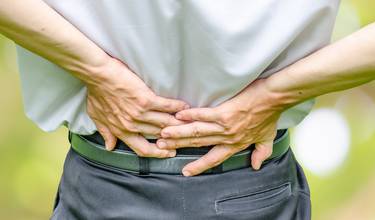What is lower back pain?
As the term indicates, lower back pain is pain located at the lower part of the back (the lumbar spine). The pain is often located in the area between the lower ribs and downwards to slightly below the muscles of the buttocks. The pain can be either mild, moderate or severe and is divided into acute or chronic pain. Acute lower back pain often lasts for less than six weeks, while chronic lower back pain can last for more than 12 weeks.
What are the lower back pain symptoms?
As mentioned, the symptoms are a variation of pain located in the lumbar spine, but the pain can also radiate down into the leg.
What are the causes of lower back pain?
Lower back pain can occur due to excessive loading and/or stretching of the muscle groups or ligaments in the lumbar spine. In most cases, the pain occurs acute, for instance as a result of having lifted too much weight. Moreover, the condition may be due to sclerosis of the skeleton or ligaments as well as a herniated disc, scoliosis (crooked spine) or collapsed vertebrae upon osteoporosis. In addition to this, research has shown that physiological relations can be the cause of lower back pain as well. The psyche may therefore act as a contributing factor to chronic back discomfort. Examples of psychological issues hereof include poor well-being, anxiety, depression or problems with alcohol.
What are the treatments for lower back pain?
Initially, medical treatment is not the preferred choice in cases of lower back pain as training/stretching of the back musculature is the best initiative towards relieving the back pain in the long term. However, should the need for immediate and significant pain relief occur, there are a number of medications that effectively relieves the pain. This type of medicine is referred to as ‘NSAID’, and has an anti-inflammatory effect. It is effective in regard to conditions in the muscle and bone structure. The most recognized are tablets called ‘Ibuprofen’, which are sold as non-prescription medication. Stronger pain relieving medicine requires a prescription.
What can I do myself to relieve the pain?
There are a number of treatments which you can use to relieve the pain, and these are as follows:
- Mobilization: Avoid lying too long in bed as bed rest weakens the musculature and delays healing.
- Heat treatment: Heat can relieve the pain.
- Activity: Physical activity can contribute to faster recovery and pain relief, but it is extremely important not to put too much load on the back too early.
- Strength training: This is essential for strengthening the musculature around the spine to reduce the risk of future lower back pain. For example, training may consist of exercises which strengthen stomach and back muscles, also known as ‘core-training’.


